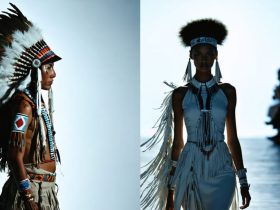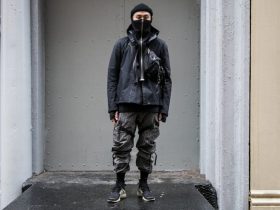In recent years,the fashion industry has undergone a remarkable conversion,emerging as a beacon of hope in the quest for sustainability. As environmental concerns and social responsibility take center stage, ethical fashion has stepped into the spotlight, guiding us towards a brighter, more sustainable future. This movement encompasses not only eco-friendly materials and fair labor practices but also a profound commitment to openness and conscious consumerism.
In this article, we will explore how ethical fashion is redefining the way we think about our clothing choices, the positive impact it yields on both the planet and communities, and the practical steps we can all take to embrace this exciting journey toward a more sustainable world.Join us as we unravel the inspiring stories behind ethical brands, examine the challenges they face, and discover how each of us can play a role in supporting a fashion revolution that’s not just stylish, but also kind to our planet and its people.
Understanding Ethical Fashion and Its Impact on the Environment

Ethical fashion represents a paradigm shift in the global apparel industry, prioritizing sustainability and ethical practices at every stage of production. This approach not only addresses the needs of consumers who are increasingly conscious about their wardrobe choices but also aims to tackle pressing environmental issues.By utilizing eco-friendly materials and innovative techniques, ethical brands reduce waste and energy consumption, creating garments that leave a lighter footprint on our planet. Some crucial aspects of ethical fashion include:
- Sustainable Materials: Utilizing organic cotton, hemp, and recycled fibers to minimize environmental impact.
- Fair Labor Practices: Ensuring fair wages and safe working conditions for all workers in the supply chain.
- Reduced Carbon Footprint: Implementing eco-conscious manufacturing processes that lower greenhouse gas emissions.
The positive influence of ethical fashion extends beyond individual choices to foster a collective responsibility towards sustainable living. Brands committed to ethical practices are reshaping consumer culture by encouraging mindful purchasing and transparency. Initiatives such as upcycling, slow fashion, and local production not only extend the lifecycle of garments but also empower communities by supporting local economies. As consumers become advocates for ethical practices, they promote a ripple effect, leading to wider adoption across the industry. A simple overview of the impact can be illustrated in the table below:
| Impact Area | Traditional Fashion | ethical Fashion |
|---|---|---|
| Waste Generated | high | Low |
| energy Consumption | High | Minimized |
| Worker Welfare | Exploited | Protected |
Promoting Fair Labor Practices in the Fashion Industry
In recent years, the fashion industry has faced increasing scrutiny regarding its labor practices. as consumers become more aware of the human cost behind their clothing, there’s a growing demand for brands to embrace fair labor practices. This involves ensuring that workers are compensated fairly, provided with safe working conditions, and treated with dignity and respect. By supporting brands that prioritize ethical labor, we not only uplift the lives of countless individuals but also encourage a shift in the industry toward more sustainable and humane practices.
Many innovative companies are leading the charge, establishing obvious supply chains and actively promoting workers’ rights. Some key initiatives include:
- Living wages: Companies commit to paying workers enough to cover basic living expenses and support their families.
- Safe working environments: Ensuring that factories meet health and safety standards to minimize hazards.
- Empowerment programs: Providing education and training to workers, enhancing their skills and opportunities.
Here’s a quick overview of how some brands are making a positive impact:
| Brand | Labor Initiative | Impact |
|---|---|---|
| Everlane | Transparent pricing | Workers earn fair wages |
| Patagonia | Fair Trade certification | Premium payments to workers |
| Reformation | Worker empowerment programs | Enhanced skills and job security |
By choosing to support brands that uphold these values, we can collectively work towards reshaping the fashion industry into one that not only values style but also prioritizes social responsibility.it’s not just a trend; it’s a movement toward a more equitable and sustainable world for everyone involved.
Finding Sustainable Materials: The Key to Responsible Production
- Organic Cotton: Grown without harmful pesticides, it reduces soil degradation and water consumption.
- Tencel (Lyocell): Made from sustainably sourced wood pulp, this biodegradable material is produced using a closed-loop process that recycles water and solvents.
- Recycled Polyester: Created from post-consumer plastic waste, it helps reduce landfill waste and lowers energy consumption during production.
Moreover, innovative technologies are paving the way for the progress of new materials that align with ethical practices. For instance, bio-fabrication techniques can produce materials from mycelium, the root structure of mushrooms, offering an eco-friendly option to leather.additionally, brands are increasingly exploring the use of waste materials, such as upcycled ocean plastics, which provide a second life to items that would or else contribute to pollution. As the industry embraces these alternatives, a table showcasing the benefits of some of these sustainable choices can illustrate their potential impact:
| Material | Key Benefits |
|---|---|
| Organic Cotton | Reduces pesticide use and encourages biodiversity. |
| Tencel | Biodegradable and produced in a sustainable manner. |
| Recycled Polyester | Diverts plastic waste from landfills and oceans. |
| Mycelium Leather | Biodegradable and sourced from renewable resources. |
Supporting Ethical Brands and Making conscious Consumer Choices
In today’s world, supporting brands that prioritize ethical practices is more crucial than ever. With a growing awareness of the environmental and social impact of fashion, consumers are empowered to make choices that align with their values. When selecting where to spend your money, consider brands that are committed to sustainable sourcing, fair labor practices, and transparent supply chains. By choosing to support these ethical brands, you not only contribute to a positive change in the industry but also send a message that conscious consumerism is an essential part of our collective responsibility.
Making informed purchasing decisions can feel overwhelming, but there are simple ways to navigate the landscape of ethical fashion. Look for labels that provide clear information about their production processes and are certified by reputable organizations. Here are some key factors to keep in mind:
- Organic materials: Opt for brands using organic cotton, hemp, or other sustainable fibers.
- Ethical Labor: Support companies that ensure fair wages and safe working conditions.
- Local Production: Choose brands that manufacture locally to reduce carbon footprints.
Below is a quick comparison of ethical certifications that can guide your shopping:
| Certification | Description |
|---|---|
| Fair Trade | Ensures fair wages and ethical working conditions for producers. |
| GOTS | Global Organic Textile Standard for organic fibers. |
| OEKO-TEX | Guarantees textiles are free from harmful substances. |
Closing Remarks
the rise of ethical fashion is not just a passing trend; it represents a pivotal shift towards a more sustainable future for our planet and its people. By choosing to support brands that prioritize fair labor practices, eco-friendly materials, and transparency, we are making a conscious decision to promote a fashion industry that values ethics over exploitation. Every purchase we make has the power to drive change, encourage innovation, and inspire others to follow suit.
As consumers, we hold the key to shaping a world where fashion is synonymous with responsibility and sustainability. Let’s continue to educate ourselves about the impacts of our choices, advocate for brands that align with our values, and share our knowledge with others. Together, we can weave a brighter, more sustainable future—one outfit at a time. Thank you for joining us on this journey,and let’s keep pushing the boundaries of what fashion can achieve!










Leave a Reply